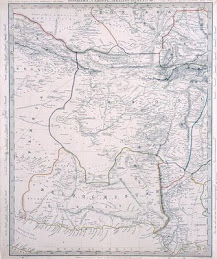While public attention focused on Afghanistan, some of the most intensive discussion focused on the country where Mr. Obama could send no troops — Pakistan. Pushed in particular by Mrs. Clinton, the president’s team explored the links between the Afghan Taliban, the Pakistani Taliban and Al Qaeda, and Mr. Obama told aides that it did not matter how many troops were sent to Afghanistan if Pakistan remained a haven.
Many of the intelligence reports ordered by the White House during the review dealt with Pakistan’s stability and whether its military and intelligence services were now committed to the fight or secretly still supporting Taliban factions. According to two officials, there was a study of the potential vulnerability of Pakistan’s nuclear weapons, posing questions about potential insider threats and control of the warheads if the Pakistani government fell.
Mr. Obama and his advisers also considered options for stepping up the pursuit of extremists in Pakistan’s border areas. He eventually approved a C.I.A. request to expand the areas where remotely piloted aircraft could strike, and other covert action. The trick would be getting Pakistani consent, which still has not been granted.
On Oct. 9, Mr. Obama and his team reviewed General McChrystal’s troop proposals for the first time. Some in the White House were surprised by the numbers, assuming there would be a middle ground between 10,000 and 40,000.
“Why wasn’t there a 25 number?” one senior administration official asked in an interview. He then answered his own question: “It would have been too tempting
Mr. Gates and others talked about the limits of the American ability to actually defeat the Taliban; they were an indigenous force in Afghan society, part of the political fabric. This was a view shared by others around the table, including Leon E. Panetta, the director of the C.I.A., who argued that the Taliban could not be defeated as such and so the goal should be to drive wedges between those who could be reconciled with the Afghan government and those who could not be.With Mr. Biden leading the skeptics, Mrs. Clinton, Mr. Gates and Admiral Mullen increasingly aligned behind a more robust force. Mrs. Clinton wanted to make sure she was a formidable player in the process. “She was determined that her briefing books would be just as thick and just as meticulous as those of the Pentagon,” said one senior adviser. She asked hard questions about Afghan troop training, unafraid of wading into Pentagon territory.
After a meeting where the Pentagon made a presentation with impressive color-coded maps, Mrs. Clinton returned to the State Department and told her aides, “We need maps,” as one recalled. She was overseas during the next meeting on Oct. 14, when aides used her new maps to show civilian efforts but she participated with headphones on from her government plane flying back from Russia.
Mr. Gates was a seasoned hand at such reviews, having served eight presidents and cycled in and out of the Situation Room since the days when it was served by a battery of fax machines. Like Mrs. Clinton, he was sympathetic to General McChrystal’s request, having resolved his initial concern that a buildup would fuel resentment the way the disastrous Soviet occupation of Afghanistan did in the 1980s.
But Mr. Gates’s low-wattage exterior masks a wily inside player, and he knew enough to keep his counsel early in the process to let it play out more first. “When to speak is important to him; when to signal is important to him,” said a senior Defense Department official.
On Oct. 22, the National Security Council produced what one official called a “consensus memo,” much of which originated out of the defense secretary’s office, concluding that the United States should focus on diminishing the Taliban insurgency but not destroying it; building up certain critical ministries; and transferring authority to Afghan security forces.
There was no consensus yet on troop numbers, however, so Mr. Obama called a smaller group of advisers together on Oct. 26 to finally press Mrs. Clinton and Mr. Gates. Mrs. Clinton made it clear that she was comfortable with General McChrystal’s request for 40,000 troops or something close to it; Mr. Gates also favored a big force.
Mr. Obama was leery. He had received a memo the day before from the Office of Management and Budget projecting that General McChrystal’s full 40,000-troop request on top of the existing deployment and reconstruction efforts would cost $1 trillion from 2010 to 2020, an adviser said. The president seemed in sticker shock, watching his domestic agenda vanishing in front of him. “This is a 10-year, trillion-dollar effort and does not match up with our interests,” he said.
Still, for the first time, he made it clear that he was ready to send more troops if a strategy could be found to ensure that it was not an endless war. He indicated that the Taliban had to be beaten back. “What do we need to break their momentum?” he asked.
Four days later, at a meeting with the Joint Chiefs of Staff on Oct. 30, he emphasized the need for speed. “Why can’t I get the troops in faster?” he asked. If they were going to do this, he concluded, it only made sense to do this quickly, to have impact and keep the war from dragging on forever. “This is America’s war,” he said. “But I don’t want to make an open-ended commitment.”
Reporting was contributed by Elisabeth Bumiller, Helene Cooper, Carlotta Gall, Carl Hulse, Mark Landler, Mark Mazzetti, David E. Sanger, Eric Schmitt, Scott Shane and Thom Shanker
Sunday, December 6, 2009
Subscribe to:
Post Comments (Atom)










































No comments:
Post a Comment